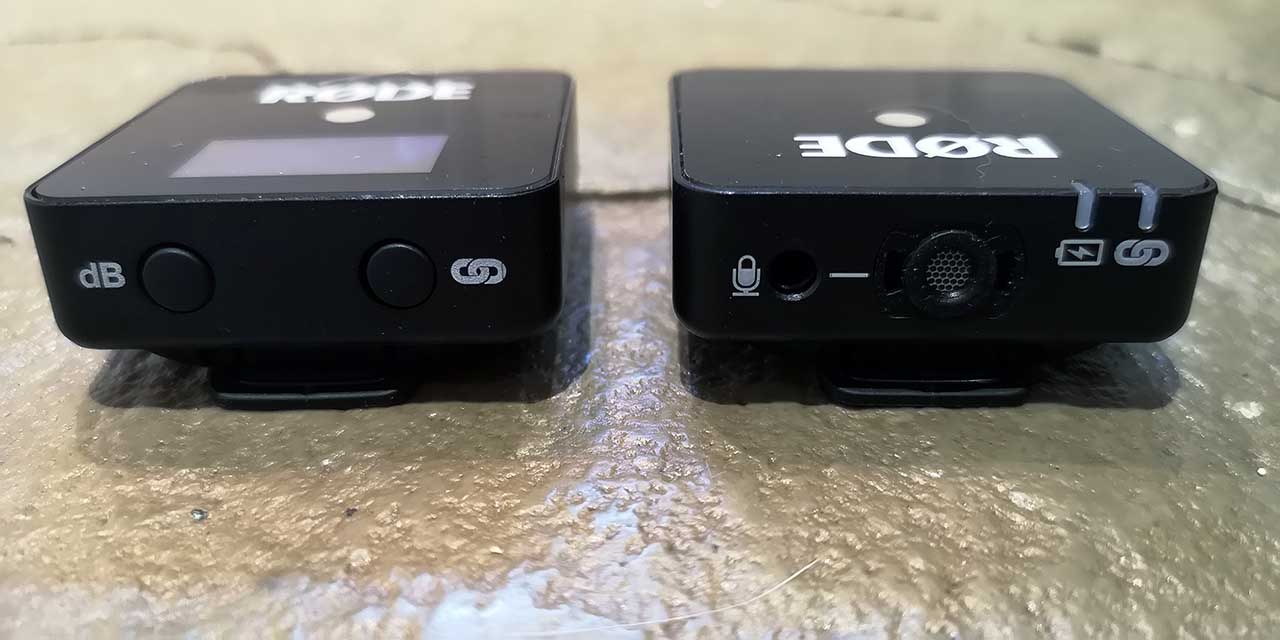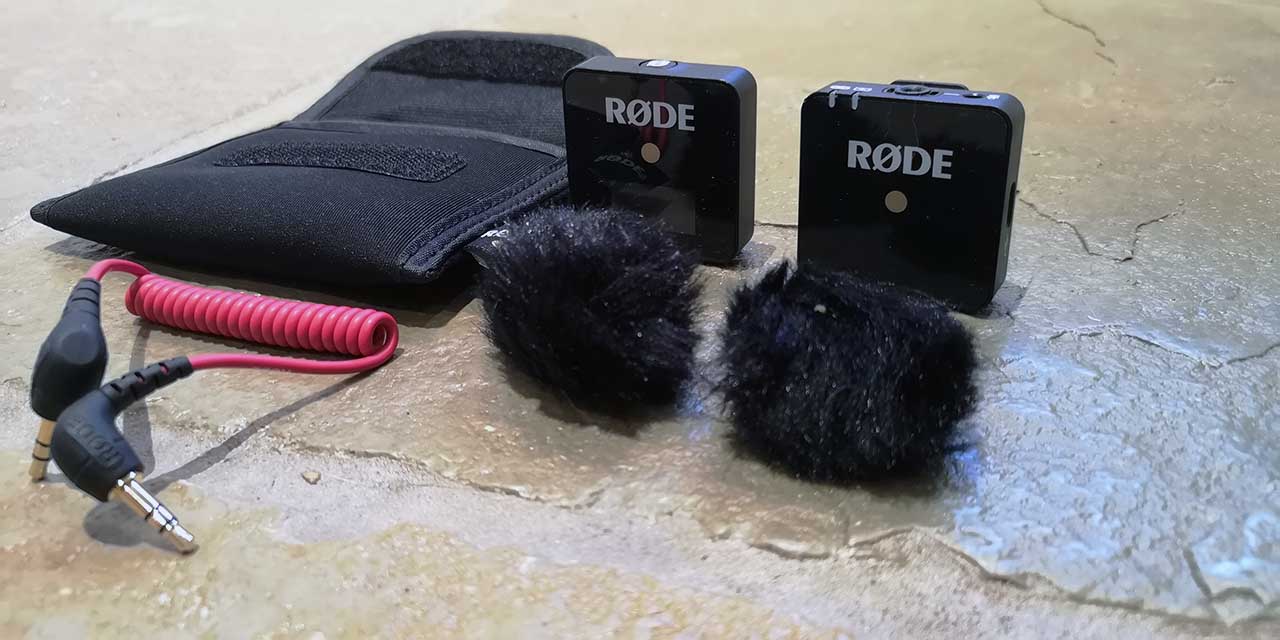What is the Rode Wireless GO?
Rode’s Wireless GO is what the company is calling ‘the world’s smallest, most versatile’ compact wireless microphone system on the market. The heart of the unit consists of a transmitter and receiver.
The unique selling point of the Wireless GO, however, is that its transmitter unit contains an omnidirectional condenser microphone and a clip. This means it can double as either a clip-on mic or a belt pack for a lavalier (either Rode’s model or a third party unit).
The transmitter then sends the audio to Rode’s Series II 2.4GHz receiver.
Update: In February 2021, Rode introduced the Rode Wireless Go II to sit alongside the original Wireless Go offering greater range and the ability to connect two transmitters. For more information, take a look at our Rode Wireless Go II review.
Features
Rode’s Wireless GO system uses a 2.4GHz frequency band and offers a range of about 250 feet. Rode designed the transmitter with a pre-polarized and pressure-operated internal capsule that features an omnidirectional pickup pattern and frequency range of 50Hz to 20kHz. It also boasts a standard 3.5mm TRS input.
Both the transmitter and receiver have a clip, and the unit runs on a rechargeable internal battery that lasts up to seven hours on a single charge.
The Rode Wireless GO also supports external battery packs during operation for continuous use.
The receiver unit has a 3.5mm TRS output for monitoring or connecting to recording devices, such as a camera or dedicated audio recorder. It also features a colour LCD screen for viewing and adjusting settings.

Build Quality
The Wireless GO system comes in a nice, soft, compact pouch for easy transport. In the kit are two USB-C cables, which I found very useful as it meant I could charge the receiver and the transmitter at the same time.
There are also two tiny dead cats you can clip onto the mic on the receiver (one is a spare). These attach quite easily and stay on well enough, but if bumped they will detach. This wasn’t a huge issue, though. Unless you’re conducting an interview in the middle of a water balloon fight, you should be fine. That said, if you’ve been following British politics of late…
The receiver and transmitter themselves are made of plastic and do feel quite plasticky, but neither do they feel cheap. They’re solid little units with chunky buttons that click reassuringly when you press them.
Each unit has a button to pair the devices should they not automatically do so. I never actually had to use this feature, but to me it illustrated the keen attention to detail Rode put into the product. Which is rare for an entry-level item, yet is a testament to Rode’s reputation for making products that just simply work without hassle.
What else? The receiver boasts a small, colour LCD that indicates the battery life of both units, as well as signal strength. Again, that attention to detail.
Another brilliant design touch is the clip on each of the transmitter and receiver. While they are strong and sturdy enough to clip to a jacket or pocket for long periods of time, the truly clever touch is that they are perfectly sized to serve as a cold shoe on your camera. Slide the receiver onto your camera’s hotshoe and it fits perfectly.
The built-in microphone sits on top of the transmitter unit, next to the 3.5mm microphone input and battery life and pairing indicators. On the side is the USB C charging port.
The receiver unit features a pairing button on the top, which sits adjacent to a button for adjusting the decibels. Again, on the side is a USB C port and the 3.5mm TRS port.
There’s a lot incorporated into these small devices, which are about the size of a new potato… which is really quite impressive.

Performance
What I liked about the Wireless GO system is that it’s so simple to use you don’t even need to read the instructions. Charge the two units with the USB C cables provided, and in an hour or so you’ll be up and running.
Slide the clip on the receiver into your camera’s hotshoe and have your subject clip the transmitter onto her lapel as a mic, and that’s really all you need to do. Even introducing a lavalier mic into the mix and using the transmitter as a belt pack is straightforward plug-and-play.
One thing to note, however (which took me several cups of coffee and maybe some swearing to figure out): the 3.5mm plugs that the Wireless GO uses typically have either three or four contacts on the male end of the plug. If you watch our review video below you can see this close up.
The Rode unit needs a plug with four contacts. My lavalier mic has a plug with three contacts, and thus it didn’t work. But I bought a cheap adapter off Amazon for around £1 and converted the three-contact plug to four. It then worked perfectly.
Let’s talk about sound quality. Using the transmitter as a clip mic, I found the sound quality superb. Using it next to a busy street where there was a steady flow of traffic, it muffled the background noise wonderfully and elevated my voice. Tones were crisp and natural, with a warmth and depth as if I was actually in the room with me when playing it back (I think I just broke my mind a little bit).
Plugging in a lavalier, I noticed the volume increase and the natural sound of my voice became a bit more computerised. Now, I should point out I wasn’t using Rode’s lavalier mic. I was using a third-party lav with an adapter (remember, the four contacts?) so this noisier, rougher sound quality is more an indictment on this combination than on the unit itself. But it’s something to consider. If you plan to use the Rode Wireless GO as a belt pack with a third-party lavalier, you might want to invest in a better lav mic, if not Rode’s offering.
In use, I found the mic unit’s range lived up to its billing. You’d be surprised how far away 250 feet feels, and I really didn’t think the receiver would pick up my voice, but it did. Flawlessly. I really couldn’t believe it.
However, this is when remaining in a direct line between the transmitter and receiver, which Rode recommends. The more obstacles between you, the greater the chance your audio may drop out.
That said, I tested the Wireless GO in a forest setting with plenty of trees and rocks and other obstacles, and I had no issues with audio dropping out. The connection was strong.
In terms of sound quality, the Rode Wireless GO also provides clear, crisp audio. Even on a busy high street it’s able to lift my voice over the ambient sounds in the background. This is thanks to the 50 Hz to 20 kHz frequency range.
One thing to note is that the sound from the Wireless GO can be quite loud, so it’s worth recording a test and adjusting the audio levels in your camera accordingly.
I found battery life as advertised at around seven hours per charge of its internal Lithium-ion batteries. The fact I could charge them via USB C cables was also very handy.
Overall, the Rode Wireless GO is the simplest mic system I’ve ever used, and yet it doesn’t seem to compromise on performance and sound quality. Whether you’re a professional journalist or a vlogger taking his or her first steps into video recording, Rode’s Wireless GO system offers something for everyone: a reliable mic system for budget filmmakers and YouTubers or a quality back-up system for professionals.
Verdict
Rode is sort of like the Toyota of video accessories. You know what it produces is going to be quality and built to last. Its top-end products are superb, but invest in its entry-level products and you know those will be better than the competition.
Rode does mics, and it does them well (neither Toyota nor Rode paid us for this commentary, by the way, but Nissan and Sennheiser are welcome to get in touch).
In short, I think Rode is on to a winner here with the Wireless GO, as aspects of it will appeal to beginners and seasoned professional alike. Not to mention its modest price tag. At around $200 / £180 it sits at nearly half the cost of some of its competitors.
But most importantly… the Rode Wireless GO just works. Plug and play, and you don’t have to worry about anything but reading your script off the teleprompter. No scanning for channels thanks to its 2.4GHz frequency band. Audio quality is superb. Battery life is long enough for most jobs, and its flexibility of USB-C charging means you can plug it into a power pack on the go.
And while you can use the transmitter as a belt pack with a lavalier mic, the Wireless GO’s built-in mic is so good and its size so small and discreet already, you don’t really need a lav.
Rode’s Wireless GO is one of the best camera accessories launched this year and is a must-have for any vlogger. It’s also the ideal back-up solution for working professionals.



